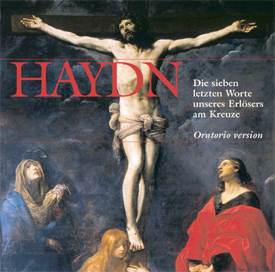Haydn’s "The Seven Last Words of Christ
on the Cross" has had a bountiful history in terms of arrangements.
Originally composed as an orchestral work in 1786, Haydn subsequently
made a string quartet arrangement, solo keyboard arrangement and
an oratorio version for vocal soloists, chorus, and orchestra.
Haydn caught the idea for an oratorio when in
1794 he heard a vocal transcription of the work in Passau on the
Danube. Haydn set to work on a vocal arrangement, making great
changes to the vocal parts he heard in Passau. Eventually, this
oratorio version became more popular than the original one for
orchestra and was published in 1801.
In current times, the only version rarely heard
is the one for solo keyboard, the other three getting fine receptions
from classical music enthusiasts. Which arrangement is best? Well,
I’m not going to tackle that issue and will simply state that
the inclusion of vocalists when setting music to a religious subject
is a time-honored tradition.
Irrespective of the arrangement, "The Seven
Last Words" is a very serious piece of music as the title
clearly reveals. I know a few Haydn fans who don’t care for the
work in any form, considering it too negative and severe with
a limited range of tempi (all slow). I do wonder if they have
taken sufficient time to really dig into the music, because it
presents a classic case of the cycle of sin, remorse, and redemption.
There is surely an uplifting element to the work that creates
subtle contrasts with the despair often possessed by Jesus and
his followers.
The 2nd Movement is a fine example
of Haydn’s ability to provide uplifting and glorious music. Paced
luxuriously and with comfort, Haydn alternates solo and choral
singing with perfection. The text’s subject revolves around the
Lord’s forgiveness of sinners, and the music fully reflects the
road from sin to redemption through faith and enlightenment. Although
Haydn’s contrasts are quite subtle, they carry a strong message.
Unlike the other arrangements, Haydn’s oratorio
version has a 2nd Introduction that is a gem. Set imaginatively
for solo wind-band, the music alternates in offering comfort and
despair. The instrumentation is a great stroke on Haydn’s part
in providing heightened contrast and a distinctive separation
between the work’s two parts. I’ve been listening to "The
Seven Last Words" for many years and am still surprised when
I hear the wind-band.
Given that Jesus’ time on earth is nearing its
end, the overt drama and urgency of the music increases in Part
II. "It is finished" marks the basic theme of the 8th
Movement, as the population keeps switching back and forth from
the horror of the situation to the prospect of eternal salvation.
Haydn gives us a very clear idea of the contrast in thinking by
starting in the traditional ‘death key’ of G minor and then using
the key of G major to reflect the optimism of Jesus’ followers.
In the 9th Movement, Haydn uses the calming key of
E flat major to convey Jesus’ last moments.
The work’s finale is an earthquake upon the death
of Jesus – "He has departed. The depths of the earth resound.
Tremble, Golgotha, tremble!". Haydn’s use of severe chromaticism
and the savage blows of the orchestra do the trick in summoning
up the image of a cataclysmic event. This is program music at
its best and most descriptive.
Brilliant Classics, in releasing a new recording
of "The Seven Last Words" in oratorio form, comes into
direct competition with the fine recording by Nikolaus Harnoncourt
with the Arnold Schoenberg Choir and the Concentus musicus Wien.
The Harnoncourt also has well known vocal soloists headed by Anthony
Rolfe-Johnson and Robert Holl, while Matt’s version has singers
of little reputation.
One area where Brilliant Classics does not succeed
concerns the matter of language texts. The text is only provided
in German, while the liner notes on Teldec also give us English
and French. The odd thing about the Brilliant Classics liner notes
is that the short biographies for Nicol Matt and the Nordic Chamber
Choir are exclusively in English, but the notes for the orchestra
are only in German. The mental processing seems random at best.
Fortunately, the performance of Matt and his
forces represents a major improvement on the booklet notes. Actually,
this is an excellent and idiomatic version that can be claimed
for just a fraction of the cost of a premium priced disc. Harnoncourt’s
Arnold Schoenberg Choir and vocal soloists certainly have the
advantage of pure beauty of tone and blending of voices with instruments.
Surprisingly, Harnoncourt’s production is also more polished than
Matt’s is, and Harnoncourt consistently employs slower tempos.
Yet, there are movements such as the 2nd
where Matt is clearly more emotionally invested than Harnoncourt.
Also, Matt’s singers are easily a match for Harnoncourt’s regarding
emotive abilities, and the earthquake conveys greater desperation
in Matt’s hands. The sole reservation I have about the performance
is that the vocal soloists sometimes overwhelm the instrumental
contributions such as in the 3rd Movement where the
soloists are projected well beyond the reticent orchestra.
Although the Brilliant Classics version is a
little rough around the edges, it fully conveys the music’s text
and Haydn’s incisive settings. There aren’t many oratorio versions
of "The Seven Last Words" in the catalogue, and I can’t
think of any reason not to add this new performance to one’s Haydn
music library. Once again, Brilliant Classics has enriched our
world of recordings, and Naxos would be wise to pay close attention
to this new and potent competitor.
Don Satz
